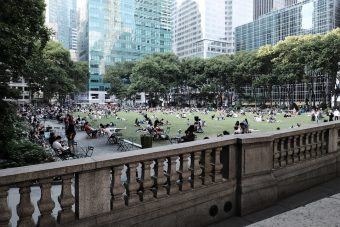Cities are home to 55 per cent of the world’s population, all jammed together cheek-by-jowl. Little wonder, then, that cities are being hit hardest by COVID-19: an estimated 90 per cent of all reported cases have occurred in urban areas.

But the same concentration of people also makes cities the places where the battle for a green recovery from COVID-19 – which is essential to reduce future pandemic risks and fight climate change – can be won.
Cities are breeding grounds for ideas and the places where many new techniques to reduce climate change, pollution, resource use and biodiversity loss are taking shape. Before COVID-19, many cities had already adopted urban farming, e-mobility, non-motorized transport, and were exploring zero emissions buildings, district energy and decentralized renewable energy systems, nature-based solutions, and retrofitting projects.
The trillions of dollars likely to be invested in COVID-19 recovery packages can accelerate such developments.
“As we respond to the pandemic and work towards recovery, we look to our cities as hubs of community, human innovation and ingenuity,” said UN Secretary-General António Guterres at the recent launch of a policy brief on COVID-19 in an urban space. “Now is the time to … recover better, by building more resilient, inclusive and sustainable cities.”
Future-proofing economies
COVID-19 recovery provides an opportunity to future-proof economies: for cities to clear their air, green their open spaces, and embrace solutions that help decarbonize and drive down resource use and related impacts on ecosystems, while creating new jobs.
Urban planning and design that helps create strategically dense cities and connects housing with transport and energy planning, as well as grey with blue and green infrastructure to harness benefits from nature-based solutions, will be critical.
Through this project, UNEP, together with C40 Cities, the World Resources Institute and ICLEI- Local Governments for Sustainability, will work with a range of cities including Freetown to push towards integrated approaches which also includes nature-based solutions.
UNEP is also working with ICLEI, through its Cities Biodiversity Center, to support multi-level governance for people and nature to live in harmony in and around our cities.
“We must pursue a green, resilient and inclusive economic recovery,” said Guterres. “By focusing on high ecological transformation and job creation, stimulus packages can steer growth towards a low-carbon, resilient pathway and advance the Sustainable Development Goals.”
Climate change: the next threat
The need for such action is urgent. COVID-19 may be currently taking centre stage, but climate change is still waiting in the wings.

Coastal cities are already enduring devastating floods, coastal erosion, sea-level rise and extreme weather events linked to climate change. Cities also suffer higher temperature than non-urban areas. Today, around 200 million city-dwellers in over 350 cities live with summer temperature highs of over 35°C (95°F). The number of cities chronically affected by heat-stress is predicted to rise to 970 by 2050. All these factors pose serious threats to people’s health and livelihoods, and our economies overall.
While cities are vulnerable to climate change, some 75 per cent of global carbon dioxide emissions are from cities. This means that the key to a decarbonized transition is held by the mayor and city councilors. Over 70 large cities, representing 425 million people, have committed to carbon neutrality by 2050. This is a start: 227 cities annually produce more than 10 million tonnes of carbon dioxide. We need a five-fold decrease in emissions to limit temperature rise to 1.5°C.
Success is possible. Cities have a long tradition of reinventing themselves, not least in response to previous pandemics that brought the introduction of sewage systems, public parks and housing regulation to improve sanitation and reduce overcrowding.
Connecting nature, climate and land use
Bangkok’s Chulalongkorn University Centenary Park is a perfect example of nature-based strategies at the crossroad of health, urban resilience and climate goals. The park’s innovative design reduces flooding risk by absorbing and storing water, which is then used for irrigation in the dry season.
Medellin in Colombia, meanwhile, has embraced nature as a cooling solution through its ‘Green Corridors’ project, transforming 18 roads and 12 waterways into lush, green havens of cool shade. The project has reduced the surface temperature in Medellin by 2-3°C while improving air quality and biodiversity.
Multi-level governance crucial
Cities and nations are increasingly working together on socio-economic recovery through multi-level governance on decision-making. Ministers and mayors recently came together to accelerate climate action in an event organized by UNEP, the United Nations Development Programme, UN-Habitat, the Global Covenant of Mayors, ICLEI and United Cities and Local Governments (UCLG).
Over 300 participants – including ministers from Italy, Indonesia, Ivory Coast, Ethiopia, South Africa, Chile, and over 25 mayors and governors – discussed coordination on climate change, particularly in key sectors such as buildings, transport, agriculture and waste management.
Green strings for stimulus packages
As all levels of government plans for socio-economic recovery, stimulus packages could support cities’ transition to decarbonization. Urban investment can promote compact, integrated, mixed-use cities that reduce the distance between place of work and place of residence. The regeneration of green spaces, rethinking urban mobility and promoting public and non-motorized transport, investing in retrofitting buildings to reduce inequalities will help improve well-being and create more jobs.
“Cities are on the frontline of impact, but also of the solutions,” said Inger Andersen, Executive Director of UNEP. “Greening cities has health benefits, helps climate mitigation and adaptation and creates jobs.”
Source: UNEP

